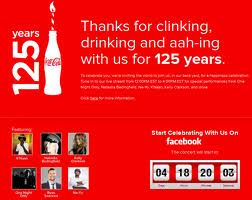125th

Menstuff® has information on
Coca Cola's 125th Anniversary and why we're not
celebrating.

Editor's note: We tried to find who the "us" was in the ad, and they're all dead. In fact, EVERYONE who has been clinking, drinking and aah-ing a Coke for anywhere close to 125 years is DEAD. Not one of them has been left alive. We were unable to find anyone of these people, anywhere in the world, to interview - including the founder or any of Coke's employees. They're all dead. I wonder if it is because they drank Coke? Something to think about the next time you get thirsty for a Coke or any other brand of soft drink - diet, or not. What Coke is really good for is to get the rust off of metal, nails, bolts, screws, etc.
Want to celebrate: Invite friends over. Take any Cokes you have left around the house, pour the contents into glasses and pass them around. Have a toast, click glasses, and pour the contents down the drain (or into the toilet which would be more significant) rather than down your throat. Then, enjoy a longer, happier life.
Cue the music; the gauzy, soft-focus ads; and the focus-grouped fridge magnets: Coca-Cola turns 125 this week.
Never a slouch in the self-promotion department, high-flying CEO Muhtar Kent had himself serenaded by a red-shirted “Coca-Cola 125th Anniversary Young People’s Chorus” to celebrate. Photos of the occasion have a vaguely authoritarian hue, as if the world’s biggest sugar water manufacturer subcontracted out its visuals to one of Pyongyang’s finest public relations firms.
Kent has something of a Ten Year Plan for the company, first floated in a chilly manifesto called “2020 Vision and Roadmap for Winning Together”—a doubling of Coca-Cola’s global revenue by 2020:
“We are laser-focused on targeting the right consumers with fully integrated global marketing campaigns that work on many levels, across many geographies and cultures, and leverage a rich variety of media and channels,” Kent says. “To target aging and affluent consumers globally, we are actively exploring new ingredients, new functionality and new occasions. At the same time, we are creating new strategies that are winning over a massive new generation of teens to drive growth of Trademark Coca-Cola.”
Whew! That’s a lot of “targeting” and “laser-focusing” and “winning over.” Unpacking all that Cokespeak, I think what Kent means is: “We want to sell more Coke to more kids more often everywhere in the world.” And that would be a public health disaster.
Besides carbonated water, “Coca-Cola’s main ingredient is high-fructose corn syrup. While no better or worse than regular sugar, that ingredient promotes weight gain and its offspring: obesity, diabetes, and heart disease. Its next ingredient is “caramel coloring,” which despite the name has little to do with “caramel” as you know it. Produced with ammonia and sulfites, industrial “caramel coloring” is contaminated with two carcinogens, 4-methylimidazole and 2-methylimidazole. Phosphoric acid erodes tooth enamel. Caffeine is a mildly addictive drug, making the concoction mildly habit forming. And, despite the efforts of dissenting Coke shareholders, Coke lines its cans with the controversial, endocrine-disrupting chemical bisphenol-A. It’s as if this drink were specifically engineered to promote health problems.
Of course, back in 1886 when morphine-addled pharmacist John Stith Pemberton invented the syrup that combines with carbonated water to make Coca-Cola, he had no idea that his concoction would become what it is today. According to the sanitized mythology on Coca-Cola.com, in its first year on sale at an Atlanta soda fountain, sales averaged just nine glasses a day.
Today, “liquid candy”—non-diet carbonated soft drinks—is the single largest source of American calories, providing about 7 percent of calories. According to our most recent Liquid Candy report, the average 13- to 18-year-old boy drinks about two 12-ounce cans of soda per day; girls of the same age drink the equivalent of one-and-a-third cans per day. Fortunately, despite the hundreds of millions of dollars Coke spends on marketing in the United States, consumption is declining. In fact, per capita sales of Coca-Cola itself have declined by 30 percent since 1998. That’s one of the best bits of health news around.
Thanks to many decades of sunny television advertising Coca-Cola conjures up warm and fuzzy feelings among many Americans. But I hope that in observance of this anniversary, policymakers and parents see through Coke’s manipulative marketing and do everything they can to drive Coke consumption down even further. Instead of doubling soda sales, as Kent envisions, let’s commit to cutting soda consumption far more by 2020. That would be a milestone worth celebrating.
Read more: www.momsrising.org/blog/coke-turns-125-why-i%e2%80%99m-not-celebrating/#ixzz1Lhtb1f00
![]()
Source: www.momsrising.org/blog/coke-turns-125-why-i%E2%80%99m-not-celebrating/
![]()

Jim Jarvis for Coke's 125th anniversary.
* * *
|
|
Menstuff® Directory
Menstuff® is a registered trademark of Gordon Clay
©1996-2023, Gordon Clay